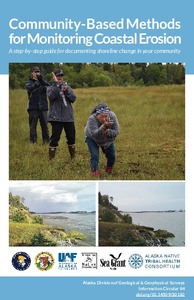Community-based methods for monitoring coastal erosion: a step-by-step guide for documenting shoreline change in your community.

View/
Average rating
votes
Date
2019Author
Overbeck, Jacquelyn
Buzard, Richard
Maio, Chris
Status
PublishedPages
35pp
Metadata
Show full item recordAbstract
This booklet provides comprehensive instructions for implementing three community-based shoreline monitoring systems, with all instructions designed to be completed by local residents. Tips for selecting monitoring sites, instructions for site installation and data collection, and all necessary materials are explained in a step-by-step format. By building an understanding of long-term shoreline change, Alaskans will be better prepared to respond and adapt to impacts to their public health, safety, infrastructure, and well-being.The majority of rural Alaskan communities are located near oceans, rivers, and lakes, and many are particularly vulnerable to shoreline change......
Resource URL
https://dggs.alaska.gov/pubs/id/30182Publisher
Alaska Division of Geological & Geophysical SurveysFairbanks, Alaska
Series;Nr
Alaska Division of Geological & Geophysical Surveys Information Circular; 84Document Language
enSustainable Development Goals (SDG)
14.AMaturity Level
TRL 9 Actual system "mission proven" through successful mission operations (ground or space)Best Practice Type
Manual (incl. handbook, guide, cookbook etc)Spatial Coverage
Chukchi SeaBeaufort Sea
Bering Sea
Arctic Region
DOI Original
http://doi.org/10.14509/30182Citation
Overbeck, J., Buzard, R. and Maio, C. (2019) Community-based methods for monitoring coastal erosion: a step-by-step guide for documenting shoreline change in your community. Fairbanks, Alaska, Alaska Division of Geological & Geophysical Surveys, 35pp. (Alaska Division of Geological & Geophysical Surveys Information Circular 84). DOI: http://doi.org/10.14509/30182Collections
- CAPARDUS Practices [244]
The following license files are associated with this item:
Except where otherwise noted, this item's license is described as Attribution-NonCommercial-NoDerivatives 4.0 International
 Repository of community practices in Ocean Research, Applications and Data/Information Management
Repository of community practices in Ocean Research, Applications and Data/Information Management
